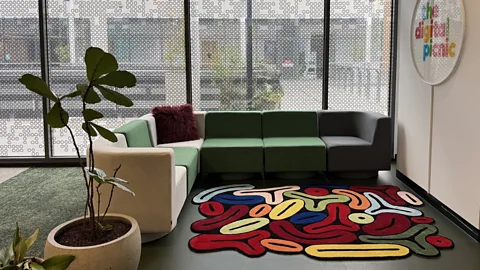Cherie Clonan, CEO of marketing agency The Digital Picnic, explains how perks like free dinners, burnout-preventing days off and even ADHD assessments have boosted employee wellbeing – and her bottom line.
If you walk into the offices of The Digital Picnic (TDP) in Melbourne, Australia, there’s a high probability that that there won’t be a single person there. While an empty office might not sound like the setting for one of Australia’s most radically inclusive businesses, it’s just one of many policies that has led to this small digital marketing agency being described by their clients as “the nicest place on the internet“, according to Cherie Clonan, the company’s founder and CEO.
At TDP, there are only six in-office days per month, on Mondays and Thursdays. The first week of each month is entirely work from home, with minimal meetings and nothing client-facing. If employees can’t face even those few days in the office, they have the option to work remotely all the time.
“We just want to get the best out of people and not chip away at their soul in order to get that,” Clonan tells the BBC.

Clonan, who was recently named Woman of the Year in the B&T Women in Media awards for her human-centred and inclusive approach to leadership, is firmly focussed on transforming workplace culture. As a proudly autistic leader, she has a unique lens on neuro-affirming work practices, centred around flexibility, empathy and accommodation, where the mental health of her team is a core focus.
“[Mental health] has never been more important,” says Clonan, who explains her priority is to foster a culture where employees can be open about their mental health without fear of stigma or judgment. “I don’t think we’re actually well as a society, off the back of some pretty big years where it was all a lot for a long time. It’s more important now than ever for organisational leaders to prioritise mental health beyond a cupcake once a year.”
It’s more important now than ever for organisational leaders to prioritise mental health beyond a cupcake once a year – Cherie Clonan
Mental health is increasingly being recognised as a crucial factor in workplace productivity and employee well-being. According to the World Health Organization (WHO), mental health conditions like depression and anxiety cost the global economy $1tn (£780bn) annually in lost productivity. And psychological well-being is now a high priority for workers too. The American Psychological Association’s 2023 Work in America Survey noted, for example, that 92% of employees surveyed said that it is “very” or “somewhat important” to them to work for an organisation that values their emotional and psychological well-being.
EXECUTIVE LOUNGE
The BBC’s series features interviews with executive leaders making innovative, data-driven decisions helping shape the future of business – and paving the path for other leaders to thrive. Read more conversations here.
Despite this growing awareness, many workplaces still lack adequate support systems. This is especially true when it comes to employees who are neurodivergent, the umbrella term that includes conditions such as autism, ADHD, dyspraxia, dyscalculia and dyslexia. For these individuals, the everyday pressures of masking their cognitive differences in workplaces designed for neurotypical people can be overwhelming, and contributes to heightened rates of stress, anxiety, depression and burnout.
According to Nancy Doyle, chief science officer at Genius Within and visiting professor at Birkbeck, University of London, who specialises in neurodiversity and disability inclusion at work, it’s vital that any trauma and burnout resulting from the workplace is seen as a systemic problem rather than individual failures. “We need to do more preventative work, looking at working conditions, hours, fair pay, sensory overwhelm, meaningful work, self-determination at work and relationships,” she says.
With WHO noting that an estimated 12 billion working days are lost every year to depression and anxiety, there is a strong argument for businesses to rethink their approach to inclusion. In fact, according to WHO, every $1 (£0.78) invested in mental health returns $4 (£3.10) in productivity gains, making mental health support not just a moral obligation but a smart business decision, they say.
We were looking at agencies who were walking 20 people out on one day through mass layoffs and quietly wondering, “What are we doing differently?”
At TDP, policies are designed to allow individuals to thrive in a way that traditional workplaces might overlook. Some accommodations are simple. Their onboarding pack for new employees includes a pair of noise cancelling headphones to help avoid sensory overload when in the office, and the freezer has ready meals for any employee to eat or take home. As well as just six office days per month, work schedules are built around an individual’s circadian rhythm, whether they prefer an early rise or can only manage an 11:00 start.
Other company policies are more radical, such as an employee benefit scheme that covers the cost of autism and ADHD assessments for any staff; as well as a paid day of “life leave” every month, on top of annual leave to compensate for the hyperfocus and resulting burnout that’s common in neurodivergent people. There’s a business commitment to promoting pregnant women (“I want people to know that they’re safe to work here as a working parent,” says Clonan) and a trans-positive inclusion policy with financial support for gender affirming surgery. Clonan has also overhauled their hiring and recruitment approach to be as inclusive as possible, including sending interview questions in advance.

While solutions and costs will vary for different businesses and workplaces, Clonan says that she sees these accommodations and policy changes as a necessary part of doing business – and that they cost no more than most workplaces spend on learning and development in a year. “I can see it in the profit and loss,” she says. “I’ve learned that it’s more expensive to have a workplace that’s not inclusive then it is to have a workplace that is inclusive.”
For example, Clonan says major policy costs at TPD include A$2,000-4,000 (£1,020-£2,040/ $1,312-$2,625) per person for an ASD or ADHD diagnosis; while for gender affirming surgery, it’s a one-time payment of A$1,000 (£510/ $655) towards, five additional days of paid personal leave, A$500 (£255/$330) for administrative expenses and A$500 for a new clothing fund.
“We factor this into our budgets, seeing it as a short-term investment for long-term gain,” says Clonan of the ROI, noting that the considerable cost of rehiring a role (“around A$33,000 (£16,815/$21,640),” she says) makes retaining talent a priority for her.
Doyle agrees inclusivity at work doesn’t need to be complicated or expensive. “Some companies are using a sledgehammer to crack a nut, as it were. I’m working with companies right now to ‘flip the cost model’ and start with a needs-led approach to all employees, embedding the easy flexes into everyday onboarding, performance appraisal and talent management.”
Clonan says TDP has grown from a tiny startup with just A$4,000 (£2,040/$1,312) in its bank account to a multi-million-dollar agency and maintained staff retention rates that surpass the industry average by an order of years, which she explains fairly simply. “Pay people well and treat them well. Surely [this] has to be the basic philosophy for business success.”
Below, Clonan talks with the BBC about the benefits of normalising mental health and how business leaders can invest in creating a more inclusive workplace.

What are the mental health ramifications you’ve seen of not being welcomed and adapted to at work?
The digital marketing industry has a notorious reputation. It can be a toxic industry to work in. It can be dangerous, especially if you have an organisational leader who’s profit over people at every touch point. In some agencies, there’s no prioritisation of mental health whatsoever, and I’m seeing people either not make it in the industry at all, or if they do, it’s not without hits and scars.
People need to radically understand themselves to bring their best selves to work. We use the Science of Leadership, which is a wheel where you can identify people sitting in the blue zone, which is happy, healed, constructive, doing their best work, living their best professional lives. That’s pretty hard to achieve. Green is more like a people-pleasing zone. A lot of neurodivergent people sit there because it’s our “fawn response” as a trauma response [to avoid conflict]. If they’ve been really hard done by in a particular workplace, they come in really red. That’s a dangerous spot for them. They’re angry burnt out, there’s a lot of ego, they’re scared, they’re threatened. They’re in fight, not flight.
We have to repeat it all the time: “You’re safe here. We want your career to explode, and we can’t do that if we’ve got this super fixed, scared, red, angry response to a lot of things. I need to know what you need so that this is a safe experience for you to work here.” And that approach has been transformative.
What tangible benefits have you seen on your employees’ mental health and your business?
Normalising mental health results in psychological safety and being neuroinclusive is good for business. In four years, we took this business from A$4,000 (£2,040/$1,312) to A$4m (£2m/$1.3m) in annual revenue, and that was through the worst time for our industry. We were looking at agencies who were walking 20 people out on one day through mass layoffs [during Covid-19], and quietly wondering, “What are we doing differently?”

Some of our staff have been here as long as we’ve been employing people, from 2018, and in our industry that is unheard of. If you don’t care what chewing people up and spitting someone out does to a person, if all that matters to you is money, know that it costs A$33,000 to replace a chewed up and spat up person because it cost A$33,000 to make any new hire. So why wouldn’t you try to commit to understanding mental health better and making any workplace a psychologically safe setting?
What are companies or leaders getting wrong when it comes to their neurodiverse workforce?
We need to represent neurodivergence beyond the ideas of “geniuses” or “increased productivity”, because that is transactional rather than transformational.
Advertisement
To get that representation I need, firstly, neurodivergent folk within my company, and then I need to make a psychologically safe workplace for them so that they have a chance to grow here. When they grow, they’re probably going to get promoted. And then I need to have some honest conversations about what more senior roles look like for them because some [neurodivergent people] have no desire to manage people. And for a lot of workplaces, that’s almost always the outcome: We can’t promote you if you’re not managing a team.
But we need to get more creative and realise that not every person’s path to growth is a promotion to management, unless they want to. And we simultaneously have to push back on this stereotypical idea that autistic people can’t manage teams. If that’s the case, why am I getting hit up every second week from people to learn from what I’m doing?
Neurodiversity in the office
Many of the world’s biggest companies – especially in tech – are actively recruiting neurodivergent workers. Deloitte notes that teams that include neurodivergent professionals can be as much as 30% more productive. “Abilities such as visual thinking, attention to detail, pattern recognition, visual memory and creative thinking can help illuminate ideas or opportunities teams might otherwise have missed,” it says in an article on how embracing neurodiversity can create a better work environment for all.
What advice would you give to another business leader looking to improve mental health in their workplace?
The best advice I can is to make sure that no accommodation is off the table. Next, invest in some training. Put leaders through mental health first aid and see if you can invest in different folks coming into your workplace to run keynotes on mental health and how it might present [at work].
Swallow your ego and recognise that you’re going to make some mistakes before you get it right. I’ve made so many myself and that’s an important, vulnerable feeling you have to sit with.
And finally, put people with an array of different lived experience in leadership positions. Homogenous workforces can be dangerous. In workplaces, you have to be able to look around and see yourself represented to feel safe.













